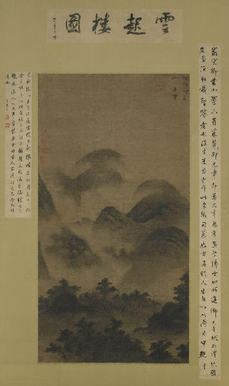Speaking of the potential of online catalogues, as I did here recently regarding exhibition catalogues, the Freer and Sackler Galleries* of the Smithsonian Institution recently announced a virtual catalogue of some of the  treasures in its collection. It put online, for everyone’s use, the “Song and Yuan Dynasty Painting and Calligraphy” resource, which contains hundreds of images, plus detailed bilingual documentation, of the Freer’s collection of 85 works of Chinese brushwork from the 10th through the 14th centuries.
treasures in its collection. It put online, for everyone’s use, the “Song and Yuan Dynasty Painting and Calligraphy” resource, which contains hundreds of images, plus detailed bilingual documentation, of the Freer’s collection of 85 works of Chinese brushwork from the 10th through the 14th centuries.
At right, for example, is Pavilion of Rising Clouds, “traditionally attributed to Mi Fu (1052-1107),” Southern Song-Yuan, mid-13th to mid-14th century, acquired in 1908. It comes with a 13-page PDF of information.
Freer-Sackler bills this resource as a pioneering effort, an “unprecedented assemblage of documentary information.”
“The new site,” a press release continues, “represents 100 years of collecting: Charles Lang Freer (1854-1919) acquired his first Song painting in 1902 and the latest addition was made by the Freer Gallery in 2002.” Read the entire release here and access the database here.
Invited, I roamed around the site — which I like. But it has (at least) two deficiencies. I’m no Chinese art scholar, but I’d still like to zoom in on the images. The technology for that exists, used by places like Sotheby’s, the Juilliard School archives, and many others.
Here’s an example of what can be done from Abbeville, a look at its new book, China. You can turn pages and zoom in and out.
More important, the project isn’t searchable. That limits its use and, at best, makes use cumbersome.
I emailed the Freer-Sackler’s press office about these problems on Tuesday, despite the east coast snowstorms, and yesterday received an answer from Julian Raby, the museum’s director.
You are quite right: currently the site lacks two important features — zooming and searching. I took the decision to make the important scholarly research on these paintings available in this technologically limited form, because it is not information available elsewhere, and the beauty of a digital presentation is that we can make improvements, to both the information and the presentation, as we move forward.
And:
We are currently completely redesigning our Collections Online, and this requires a thorough overhaul of the underlying architecture and programming. The aim is to connect information on our collections on the website to our museum management system, which is the one most widely used by museums across the States. There will be a completely new Search facility for the entire Collections site, and Zoomify.  
We hope to have this new Collections site up and running later this year.
So, a happy ending — if delayed.BTW, the Freer-Sackler has another online catalogue, for a ceramics collection, but it too has limitations. Photo: Courtesy Freer-Sackler
*A consulting client of mine supports the Freer-Sackler.
